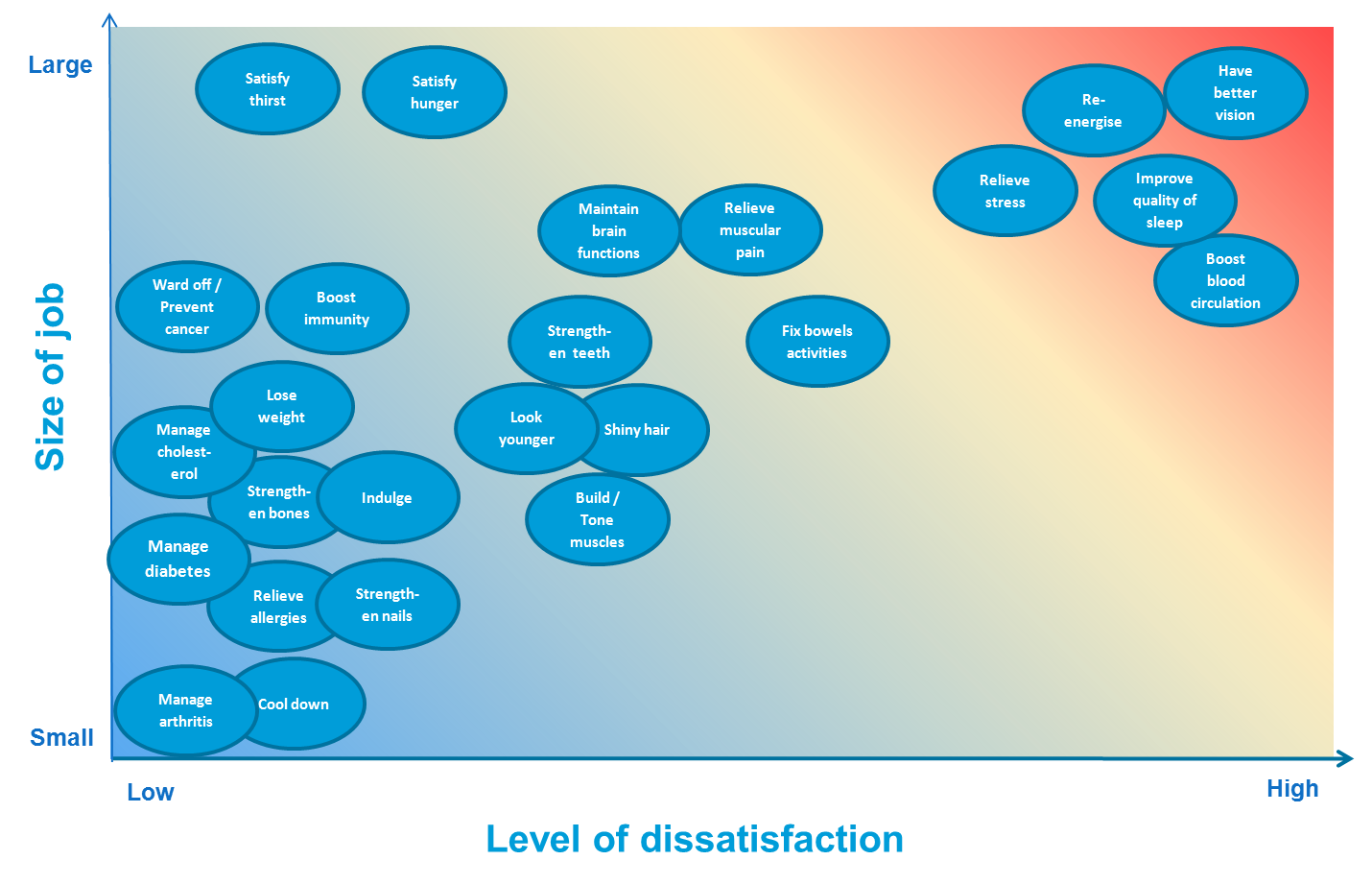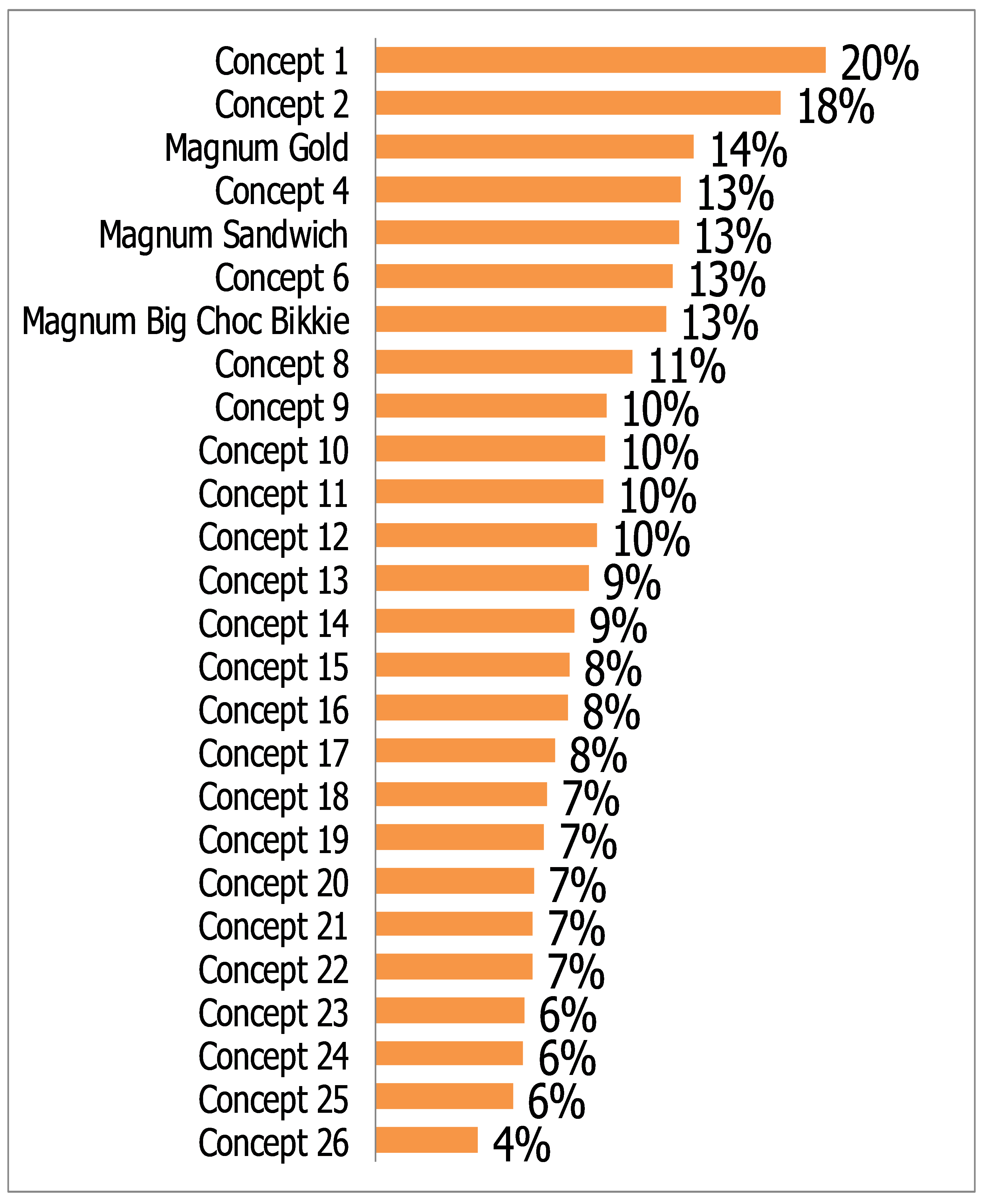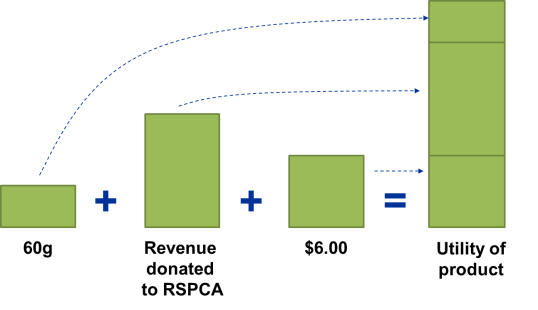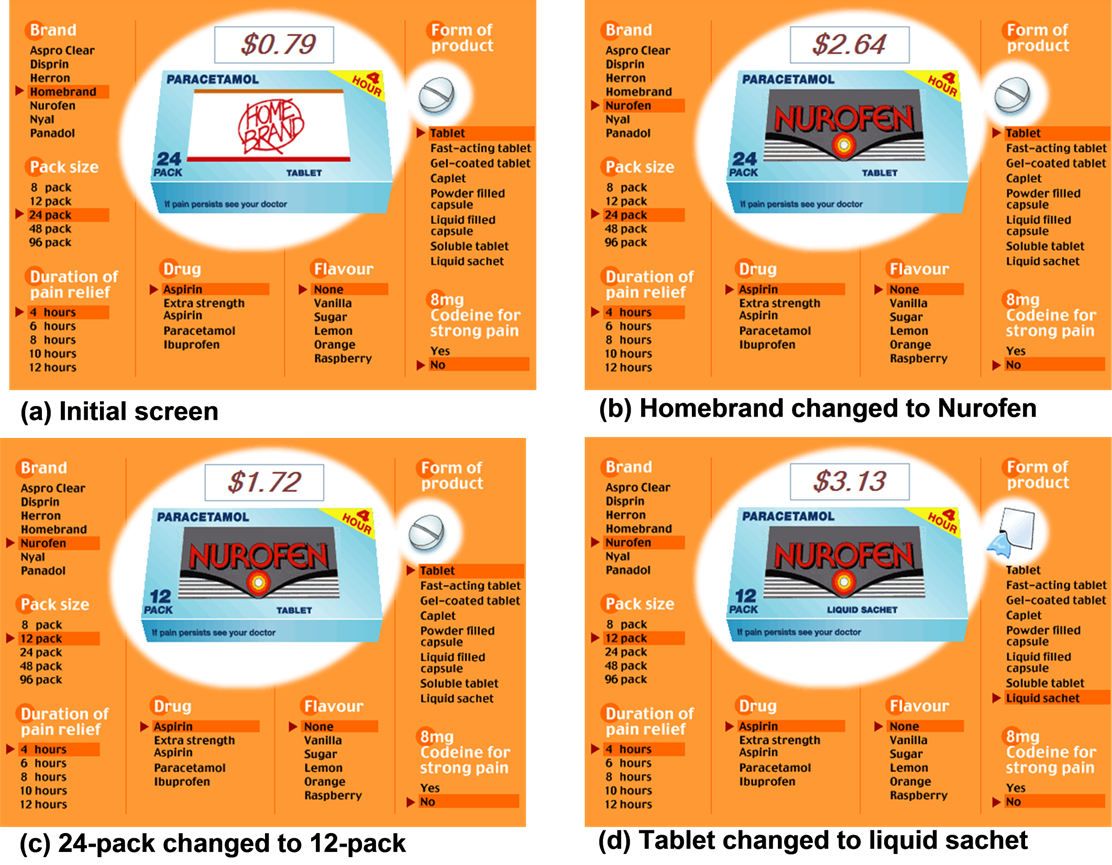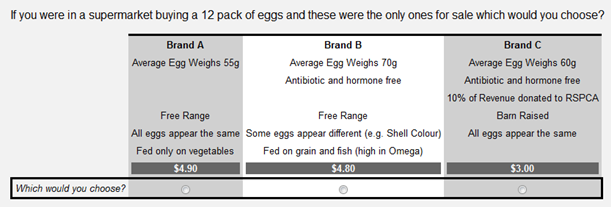New Product Development
Ideation
The basic idea
Once a firm has identified the general area on which it wants to concentrate its new product development efforts, the next step is to come up with ideas. Sometimes this is done by technical specialists, such as food technologists and engineers. However, in other situations it is done using ideation. When market researchers are involved this ideation tends to involve consumers, but the same basic method can be used with stakeholders and other employees of the company. Ideation is short for idea generation. Ideation itself is just an application of brainstorming.
Brainstorming
The basic logic of brainstorming is this: the best way of coming up with a good idea is to come up with lots and lots of ideas. A team that creates 50 ideas and chooses the best will, in general, end up with a much better idea than a team that that comes up with only 20 ideas. A way of coming up with lots of ideas is as follows:[1]
- Get a group of people together, but get each to initially work on their own. The widespread belief that people get ideas by bouncing off each other is not supported by evidence.
- Give people a specific target in terms of the number of ideas to come up with. For example, give them a target of 10 new ideas in 10 minutes. The trick is to make the target hard – the harder the target, the more ideas people will create. Furthermore, the specific goal is to come up with lots of ideas, not a small number of good ideas, and people should be instructed that quantity, not quality, counts.
- Then, as a group, review the ideas to identify winners.
Encouraging creativity
Ideation projects usually contain a couple of twists on traditional brainstorming. One of the twists is to give people a warm up task to encourage their creativity. The other is to give them tasks designed to guide them towards better ideas.
Example of a warm up task[2]
- Generate two lists each of four random words (e.g., by randomly opening pages of a dictionary). For example:
toast runway prophet formula chip lollipop tail pyramid
- On some basis, pair words in each of the lists
- Define the basis for the pairing. For example:
“toast” and “prophet” are both edible “tail and "formula” can be very long “profit” and “runway” suggest departure for the future
SCAMPER
SCAMPER is a checklist of activities designed to spur creative thinking, all of which start by thinking about how to modify an existing product or service:
- Substitute something
- Combine it with something else
- Adapt something to it
- Modify or Magnify it
- Put it to some other use
- Eliminate something
- Reverse or Rearrange it
Gap Identification
The most common role that market research plays in helping companies to create new products is to identify gaps in the market, where a gap is an unmet need, want or identification of a problem with existing products. This page describes three related approaches to this problem; there are numerous other approaches.
Jobs-to-be-done
Any purchase can be thought of in terms of the jobs that need to be done which motivate the purchase. When buying a car, we may have in mind the jobs of getting to work, transportation to holidays and keeping up with the Joneses. When buying yogurt, the jobs to be done may include functional jobs, such as losing weight and satisfying hunger, emotional jobs such as making us happy and social jobs such as impressing people. The jobs may need to be done regularly, such as filling our stomachs, or they may be one-off jobs. They can be driven by a specific situation, such as having had to skip a meal, or be intrinsic to the person, such as a desire for a snack at the same time every day. The following table shows jobs to be done in the yogurt category.
| Satisfy hunger | Lose weight / Maintain current weight |
| Boost blood circulation | Manage arthritis |
| Boost immunity | Manage cholesterol |
| Build / Tone muscles | Manage diabetes |
| Cool down | Relieve muscular pain |
| Ease allergies | Relieve stress |
| Fix / Maintain digestion / bowels activities | Re-energise |
| Improve brain functions (e.g. Memory, alertness) | Satisfy thirst |
| Improve vision | Strengthen bones |
| Improve quality of sleep | Strengthen nails |
| Have shiny hair | Strengthen teeth |
| Indulge | Ward off / Prevent cancer |
| Look younger |
Note how different these are to generic statements of benefits and needs; they are all precise descriptions of activities that people do, or things they may want a yogurt to provide. When trying to come up with a list of jobs, it can be useful to focus on ancillary jobs, which can be split into related and unrelated ancillary jobs. When Apple launched the iPod, it not only provided a device for playing music, it also solved the related problems of buying and cataloging music. Similarly, Nespresso solves the problem of buying, storing and grinding coffee. Non-related jobs are jobs that can be done at the same time, such as taking photos with a camera or drinking coffee while driving (which is facilitated by cup-holders).
Constraints
Once we have identified the jobs-to-be-done, there are usually two ways that we can get more detailed information about the jobs. We can focus on constraints that prevent jobs from being done well and outcomes which are desired from jobs. It is often helpful to prioritize jobs to be done in terms of how many people need to do these jobs, how important they are and how dissatisfied people are (each of which can can be measured using standard questions in a questionnaire (e.g., How important...). If a job is common, important and people are dissatisfied with the products they currently use for the job, then the job presents more of an opportunity. For example:
A constraint is something that prevents a job from being done or adversely impacts the outcome. The identification of constraints can be particularly helpful with new product development. When we focus on what consumers want, we are leaving it to the consumer to tell us what innovations they desire and they often do not have the insight or understanding of possibilities to be able to do this. Think about the coffee market five years ago. Research continued to show the important emotional and social role of coffee. The true aficionados wanted to be baristas in the comfort of their own homes. And what new products were targeted at this segment? Mini industrial coffee makers, designed to replicate the gourmet café experience, but with an emphasis on simplicity and ease of cleaning.
The Nespresso machine has been the standout success in this segment in recent times. Interestingly, it fails in terms of most of the key needs were identified if research into coffee before the Nespresso was launched. The user is nothing like a barista; they just drop a pod into a machine and press a button. How could such a functional product meet the market’s aspirations? It does so because it deals with all the constraints of the coffee making jobs. It is very fast. It is easy to clean. People can have much greater control over getting their perfect brew, with different varieties of coffee for every person. They can order online.
Outcomes
It can be useful to break down a job into a series of outcomes. An outcome is an assessment of how well a job has been done. For example, these outcomes relate to the ‘satisfy hunger’ job performed by yogurt:
| Decrease price / cost | Increase enjoyment |
| Decrease time taken to plan meal | Decrease guilt |
| Decrease time taken to shop | Decrease saturated fats |
| Decrease serving difficulty | Decrease calories |
| Decrease consumption difficulty | Decrease food intolerance |
| Decrease time to prepare | Increase ease of eating ‘on the go’ |
| Decrease time to clean up | Increase environmental sustainability |
| Increase time until I become hungry next |
Identifying and measuring jobs-to-be-done, constraints and outcomes
Jobs, constraints and outcomes are relatively easy to identify through any or all of qualitative research, introspection, discussions with stakeholders and reviewing previous studies. Various Ideation techniques, such as SCAMPER, can be useful.
If an outcome is both important and consumers believe that current products do badly on the outcome, this suggests that there is a gap in the market relating to this opportunity. One method for quantifying the resulting opportunities is to:
- Get consumers to rate the importance of each outcome on a scale of 1 to 10.
- Get consumers to rate their current level of satisfaction with the products they currently buy in terms of addressing these outcomes on a scale of 1 to 10.
- Prioritize the opportunities with the highest score, where the score is computed as:
Opportunity = 2 × Importance - Satisfaction
There is no great weight of scientific evidence behind this formula, but it is a useful place to start.
Concept Test
A concept test is used for measuring and understanding the appeal of a new product.
The concept board
Concept testing generally involves creating concept boards, which explain the new product to consumers, giving them enough information so that they can have a meaningful reaction when asked if they will or will not buy it. For example, this concept board was used to test the appeal for Magnum Gold prior to its launch.
Copyright Unilever Australia (used with permission)
The success of a concept test hinges on the quality of the concept’s description. It is not unknown for 20 minutes to be spent educating the respondent about a concept, but in most studies consumers get 10 to 20 seconds (which is likely sufficient for simple concepts).
If a concept board is insufficient to accurately get consumers to evaluate a concept then consumers may also be given an opportunity to trial the product. Most commonly, products will be shipped to consumers’ houses (this is called -in-home placement), or consumers will go to a central location where the concept testing may also involve some sensory research (research designed to get specific feedback on how to improve the sensory aspects of the food, such as smell, taste and viscosity). When presenting radical new technologies, the process of respondent education is called information acceleration.
The impact of respondent education can be great. One study found that after describing a concept, the proportion of respondents who said they would ‘definitely’ or ‘probably’ buy was 59% at $1.59 and 59% at $2.29 (i.e., the price had no effect). However, when the same study was conducted with an in-home use component (i.e., leaving the product with the consumers for a few weeks), price had a large effect, with the stated intention to buy being 64% at the lower price and 48% at the higher price.
When presenting complex concepts to respondents it is advisable to test for comprehension in some way, such as in Q1 of the questionnaire below.
In addition to respondent education, questions should be incentive compatible, and this is harder to achieve. Our concern is not simply one of respondents trying to mislead. There is also the issue of whether respondents will put as much effort in to answering the question as they would in a real-world purchase situation (as if their efforts are different, then their answer in the questionnaire will be unlikely to reflect what they do in reality). Most concept tests use the same structure, although questions are modified and added as required:
Concept testing questionnaire
SHOW CONCEPT BOARD
Please look at the description of the product. Please take as much time as you need to look at it. We will then ask you some questions about the product.
Q1. Is there anything in this description that you do not understand or would need more information about in order to decide whether or not to buy this product? If so, what? OPEN-ENDED
‘Q2. What, if anything, do you think you would particularly like about this product? OPEN-ENDED
Q3. What, if anything, do you think you would particularly dislike about this product? OPEN-ENDED
Q4. Which phrase from those below best describes how likely you would be to buy the product for yourself?
I would definitely buy it I would probably buy it I am not sure whether I would buy it or not I would probably not buy it I would definitely not buy it
Q5. On average, how often do you think it would be eaten?
Every day Two or three times a week Once a week Once every two/three weeks Once a month Once every two/three months Once every four/six months Less often than every six months Never
Q6. Compared with similar products how different do you think this product is?
Very different Different A little different Not very different Not at all different
Q7. How well do you think the idea for this particular snack fits what INSERT BRAND NAME means to you?
1 Does not fit at all
2
3
4
5
6
7
8
9
10 Fits extremely well
Q8. Do you have any further comments about this product? If so, what? OPEN-ENDED
Qualitative concept testing
Where the concepts are being tested using qualitative research, a similar structure is usually followed, although commonly with a general exploration of needs and wants at the beginning of the study (this can also occur with quantitative studies). Where the purpose of the concept test is to refine concepts, rather than work out which are most appealing, qual is usually more appropriate due to the potential for more depth from the diagnostics.
Analysis
Typically a concept test will involve multiple separate concepts, which are evaluated based on a combination of relative performance against each of the other concepts and internal benchmarks. Usually the key question that is used to evaluate whether the concept is a winner is Q4, which is referred to as the purchase intent question. The Magnum concept shown above was one of 26 concepts tested. The resulting concept scores were:
Large companies typically keep records of previous concept tests and develop benchmarks for new products. Common benchmarks include getting a top two box score of 60%, or a top box score, which is also referred to as a DWB (“Definitely Would Buy”) of 25%. Such benchmarks are rarely valid.[3] This is because people are not able to accurately state their future behavior (how can they know how much they will like an ice cream before they have eaten it) and because many other factors determine the success of a new product, such as distribution, word-of-mouth, and so on. For example, Magnum Gold’s top box score (the proportion of people to say they would ‘definitely’ buy) was 14% and its top 2 box score was 38%, which are below most commonly-used thresholds. Despite this, it went on to become the top selling ice cream in Australia. Many other products have passed these thresholds and failed.
Although it is not unusual for companies to take the approach of launching product(s) that ‘win’ the concept testing, this can be dangerous, as consumers have a tendency to give higher ratings to concepts that are similar to successful products already in the market. Consequently, the products with the highest purchase intent often face the stiffest competition if launched. One solution to this is to prioritise concepts based on a combination of purchase intention and uniqueness (e.g., as measured in Q6).
Choice Task
The purchase intention questions in a traditional Concept Test likely measure desire rather than true intention. Desire is infinite and resources are finite and we should expect that purchase intention questions will over-state demand. A solution to this problem is to ask consumers to choose from multiple products. Such choice tasks have the important advantage of most closely replicating the real world tasks that shoppers perform. For example:
If you saw the following products at these prices when you were next shopping for baby food, which of these would you buy?
Most commonly, consumers will be presented with a single screen (or piece of paper) containing descriptions of the new product and competitor products in the market segment and their prices. Consumers are asked to select only one of the brands. As they have had to make a choice between all of the available alternatives, the data implicitly takes into account the finite nature of consumers’ resources, and we expect (and often observe) a high correspondence between the proportion of respondents who select a product and the true proportion who buy it in the real world.
Of course, there is something a bit unnatural about such choice tasks, containing one new product and existing products. The poorer the correspondence between the real-world and a question being used to predict real-world behavior, the less accurate we should expect the question to be. This is referred to as ecological validity. A solution of sorts to this is to Choice Modeling, as with a choice model all of the alternatives are artificial and thus the problem of one being new is not a source of bias.
Where consumers are likely to change their purchasing in different situations (e.g., meal occasions), or due to variety seeking, these can be addressed by occasion-cuing the questions (e.g., “thinking about your last trip”, or, “thinking about your last time you went to the football”) or by using Constant-Sum questions (e.g., “thinking of your next 10 purchases, how many of each of these products would you buy?”).
Many choices tasks include an “I would not buy any of these” option. Such descriptions should only ever be included when it is a realistic outcome. As an example, if modelling airline choice, it is clearly realistic to permit a consumer to say they would choose not to fly given the available alternatives. By contrast, if modelling choice of beverage on a hot day, the inclusion of the “none” option is problematic, as in reality the consumer is likely to be forced to choose between the brands in the choice task and may select “none” as a way of signalling that they do not like these brands (even though if presented with only these brands they probably would have actually chosen one of them).
Experiments
Discrete Choice Experiments
There is a relatively simple approach to dealing with the problem of pricing the iPad which was discussed in Basic Questionnaires. The solution is to conduct an experiment, showing different people the iPad at different prices and asking them if they will or will not buy the product. For example, some people could be shown a price of $500, some $750, some $1,000 and so on. As the respondent cannot know that the experiment is designed to understand the effect of price, they have no way of providing misleading answers in order to gain a benefit. Thus, the question becomes incentive compatible.
Common types of experiments used in market research
- Completely Randomized Designs. Each respondent is shown one and only one thing (e.g., the example above).
- Max-Diff
- Conjoint Analysis
- Discrete Choice Experiments


